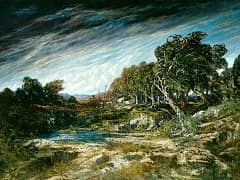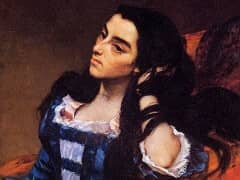Stormy Sea, 1869 by Gustave Courbet

Considered to be one of the first Realist painters and credited with coining the term, Gustave Courbet painted landscapes, seascapes and figural compositions using a heavy brush stroke and limited color palette. Challenging artistic convention, Courbet rejected the idealistic religious, mythological and allegorical subjects of traditional painting, preferring instead to paint the common people of the day, often on a scale previously reserved for history painting. Though his realistic and sometimes provocative portrayal of modern day subjects often put him at odds with the academy and art critics, Courbet inspired future Impressionists and helped paved the way for modernist art.
Courbet's portrayal of the sea ripped by storm is divided neatly into two sections, the bottom half of the scene being overtaken by waves whipping ashore while heavy clouds drift above, imitating the sea's swirling motions. The muted color palette is limited primarily to the the white and grey tones of the wave caps and clouds through which the brown shore, deep blue sea and dark-blue sky are seen. The waves are painted with thick brush strokes - possibly with the use of a palette knife - conveying the heavy intensity of the thundering sea.















